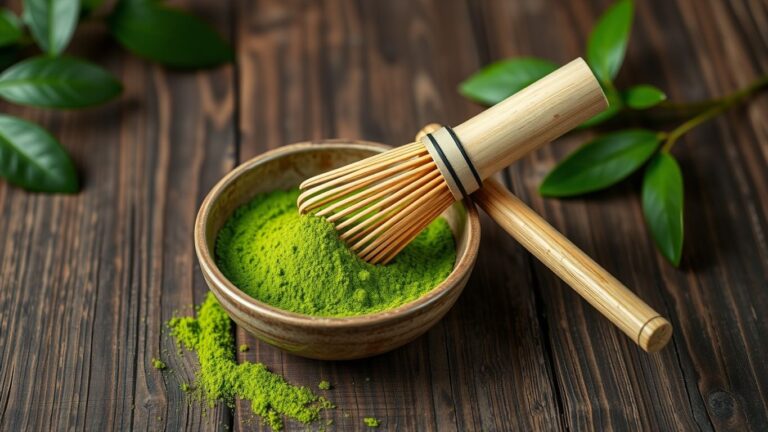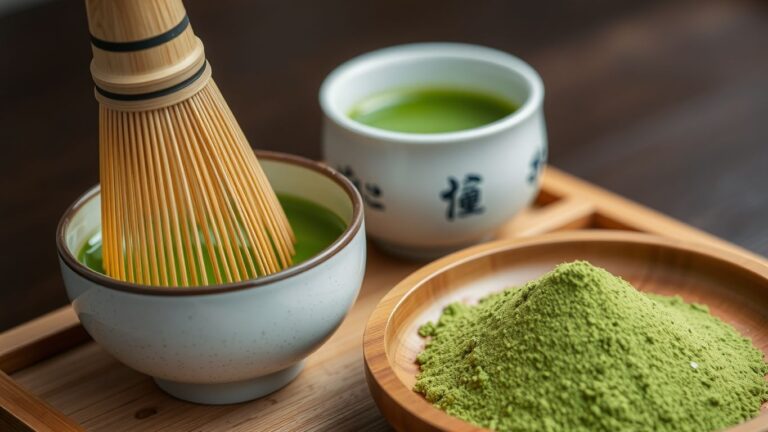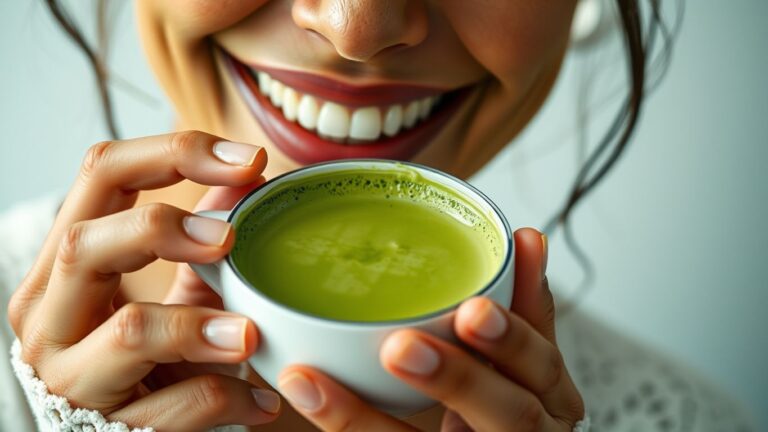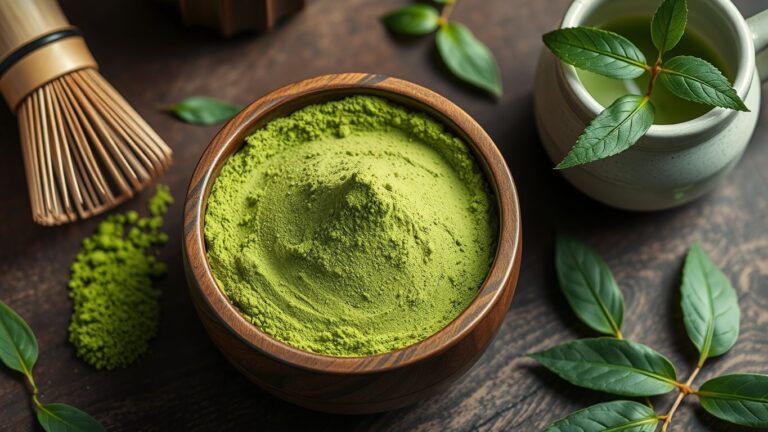Matcha is a special type of green tea that has many health benefits, but its strong taste can be hard to get used to. Thankfully, there are plenty of ways to make matcha taste better. Whether you’re new to matcha or looking to improve your current matcha experience, these tips and tricks will help you enjoy every sip. From choosing the right matcha to adding natural flavors, this guide covers everything you need to know.
Key Takeaways
- Start with high-quality matcha to avoid bitterness.
- Proper whisking techniques can improve the flavor and texture.
- Using the right water temperature is crucial for the best taste.
- Natural additives like honey and citrus can enhance the flavor.
- Store matcha properly to maintain its freshness and taste.
Choosing the Right Matcha for Better Taste
Selecting the right matcha is crucial for a delightful experience. Here’s how you can ensure you’re getting the best matcha for a superior taste.
Mastering the Art of Whisking
Whisking matcha properly is crucial to achieving that smooth, frothy texture that enhances its flavor. Here are some tips to help you master the art of whisking matcha.
Proper Whisking Techniques
To whisk matcha effectively, you need the right tools. A traditional bamboo whisk, known as a chasen, is ideal. The number of tines on a chasen can make a big difference in how well the matcha powder disperses. Aim to whisk in a rapid zigzag motion, forming an "M" or "W" shape. This technique helps create a beautiful light green foam on top, giving the tea a smoother and creamier texture.
The Importance of Creating Foam
Creating foam is not just for aesthetics; it significantly improves the texture and taste of your matcha. The foam gives the tea a creamy mouthfeel and helps to balance its natural bitterness. Practice makes perfect, so don’t be discouraged if your first few attempts aren’t perfect. Keep practicing, and you’ll soon be able to whip up a frothy bowl of matcha in no time.
Common Whisking Mistakes to Avoid
Avoid using kitchen whisks, spoons, or forks, as they won’t mix the matcha properly and will leave clumps at the bottom of your cup. Also, be cautious not to stir the matcha; whisking in a zigzag motion is key. Lastly, make sure to sift your matcha powder before whisking to prevent clumps and ensure a smooth, enjoyable drink.
Optimizing Water Temperature and Quantity
Ideal Water Temperature for Matcha
Getting the water temperature right is crucial for making matcha taste its best. Using water that’s too hot can make your matcha bitter. Aim for a temperature between 160°F and 175°F. If you don’t have a thermometer, wait a few minutes after boiling water to let it cool down. This range helps to bring out the umami and sweetness without the astringency.
Using the Right Amount of Water
The amount of water you use can also affect the taste. For a traditional bowl of matcha, use about 2 grams of matcha powder with 100 ml of water. This ratio ensures a balanced flavor. If you prefer a stronger taste, you can use less water. For a milder flavor, add a bit more water.
How Water Quality Affects Taste
Water quality is another factor that can influence the taste of your matcha. Use filtered or spring water for the best results. Tap water can contain minerals and chemicals that may alter the flavor. Always use fresh, cold water and avoid reboiling water, as it can make the matcha taste flat.
Remember, the key to a delicious cup of matcha is not just the quality of the powder but also how you prepare it. Pay attention to the water temperature and quantity to enhance your matcha experience.
Enhancing Flavor with Natural Additives
Adding natural ingredients to your matcha can make it taste even better. Here are some tips to enhance the flavor of your matcha using natural additives.
Incorporating Matcha into Smoothies and Lattes

Matcha Smoothie Recipes
Adding matcha to your smoothies is a fantastic way to boost your energy and nutrition. This matcha smoothie recipe will energize you in an instant. Combine matcha tea, yogurt, almonds, spinach, and kale for a tasty sip. You can also experiment with fruits like bananas and berries to add natural sweetness.
Creating the Perfect Matcha Latte
Making a matcha latte at home is easier than you think. Start with 1 tsp of ceremonial grade matcha tea, 4-6 ounces of off-boil water, and 6 ounces of warmed non-dairy milk. Add a splash of vanilla extract or a dash of cinnamon for extra flavor. Whisk until frothy and enjoy!
Dairy-Free Alternatives for Matcha Drinks
If you’re avoiding dairy, there are plenty of options for you. Almond milk, oat milk, and coconut milk all make excellent bases for matcha lattes and smoothies. These alternatives not only complement the flavor of matcha but also add their own unique taste and texture.
Experimenting with Matcha in Cooking and Baking
Matcha isn’t just for drinking; it can be a versatile ingredient in your kitchen. Using matcha in cooking and baking opens up a world of unique flavors and vibrant colors. Here are some ways to incorporate matcha into your culinary creations.
Matcha in Baked Goods
Adding matcha to baked goods is a fantastic way to enjoy its benefits without the strong taste. You can mix matcha powder into cakes, cookies, and muffins. The earthy flavor of matcha pairs well with sweet ingredients, creating a balanced taste.
Savory Dishes with Matcha
Matcha isn’t just for sweets. It can also enhance savory dishes. Try adding a pinch of matcha to soups, sauces, or even as a seasoning for meats. The subtle bitterness of matcha can add depth to your savory recipes.
Matcha-Infused Snacks
For a quick and healthy snack, consider matcha-infused options. You can make matcha energy balls, granola bars, or even sprinkle matcha on popcorn. These snacks are not only delicious but also packed with antioxidants.
Experimenting with matcha in your cooking and baking can transform ordinary dishes into extraordinary culinary delights. Don’t be afraid to get creative and explore the endless possibilities of this versatile ingredient.
Using Less Matcha for a Milder Flavor
Adjusting Matcha Quantity
The flavor of matcha is directly tied to the amount you use. If you find the taste too strong, simply use less matcha. Start with a small amount and gradually increase it as you get used to the flavor. This is especially helpful for beginners who are new to matcha.
Balancing Matcha with Other Ingredients
Matcha can be a side character rather than the star of your drink. Try adding matcha to smoothies, yogurt, or even pesto for a perfectly subtle earthy flavor. This way, you can enjoy the benefits of matcha without it being too overpowering.
Introducing Matcha to Beginners
For those new to matcha, it’s best to start with a milder version. You can always add more matcha later, but it’s hard to take it out once it’s in there. This approach makes it easier for beginners to appreciate the unique taste of matcha.
Using less matcha is a simple yet effective way to make your drink more enjoyable. Start small and adjust as needed to find your perfect balance.
Storing Matcha Properly to Maintain Freshness
To keep your matcha tasting its best, proper storage is key. Storing matcha in a dark, airtight container helps preserve its beautiful green color and prevents that metallic taste that can develop from light exposure. Here are some tips to ensure your matcha stays fresh and flavorful.
Best Storage Practices
- Use an Airtight Container: Matcha is sensitive to air, which can cause it to oxidize and lose flavor. Always store it in an airtight container to keep it fresh.
- Keep It Cool: After opening, it’s recommended to store your matcha in the fridge. This can keep it fresh for up to 6 months.
- Avoid Light: Light can degrade matcha, so always store it in a dark place or use an opaque container.
Recognizing Stale Matcha
Stale matcha loses its vibrant green color and may taste bitter or dull. If your matcha has turned a yellow-green or brownish color, it’s likely past its prime.
Reviving Old Matcha
If your matcha has lost some of its freshness, you can still use it in cooking or baking. While it might not be ideal for drinking, it can add a unique flavor to your recipes.
Avoiding Common Matcha Preparation Mistakes

Making matcha can be tricky, but avoiding some common mistakes can make a big difference in taste. Here are some tips to help you out.
Overheating the Water
Does your matcha taste bitter? You might be using the wrong water temperature. Using hot water that is above 176°F (80°C) may cause matcha to become bitter. The best way to get the right temperature is to use a variable temperature kettle. If you don’t have one, let boiling water cool for about 5 minutes before using it.
Skipping the Sifting Step
Matcha powder clumps easily, which can make it hard to whisk and less tasty to drink. Sifting the powder before you whisk it can make a big difference. Use a tea strainer or sieve to break up the clumps and make your matcha smooth.
Using the Wrong Tools
Whisking matcha with a spoon or fork won’t work well. You need a special bamboo whisk called a chasen. This tool helps mix the powder evenly and creates a nice foam on top. If you don’t have a chasen, a small kitchen whisk can work in a pinch, but it’s not ideal.
Avoiding these common mistakes can make your matcha taste much better. Practice makes perfect, so keep trying until you get it just right!
Pairing Matcha with Complementary Foods

Pairing matcha with the right foods can elevate your tea experience to a whole new level. Here are some great combinations to try out.
Matcha and Dairy Pairings
Dairy products like milk and cream can help balance matcha’s natural bitterness. A matcha latte is a popular choice, blending the earthy flavors of matcha with the creamy texture of milk. You can also try matcha with yogurt or even ice cream for a delightful treat.
Fruits that Enhance Matcha Flavor
Fruits can add a refreshing twist to your matcha. Citrus fruits like lemon and orange zest can brighten up the flavor, while berries like strawberries and blueberries offer a sweet contrast. You can even blend matcha into a fruit smoothie for a nutritious and tasty drink.
Matcha and Nut Combinations
Nuts like almonds and cashews pair wonderfully with matcha. The rich, nutty flavors complement the tea’s earthy notes. Try adding a handful of nuts to your matcha smoothie or sprinkle some matcha powder over a bowl of mixed nuts for a quick snack.
Exploring Flavored Matcha Options

Flavored matcha is a delightful way to enjoy the benefits of matcha while indulging in a variety of tastes. The matcha is a beautiful bright green, exuding a fresh aroma. Let’s dive into some popular flavored matcha varieties and how you can make your own.
Popular Flavored Matcha Varieties
There are many flavored matcha options available, each offering a unique twist on the traditional taste. Some popular varieties include:
- Chocolate Matcha: A rich and decadent option for chocolate lovers.
- Vanilla Matcha: Smooth and creamy, perfect for a comforting drink.
- Fruit-Flavored Matcha: Options like strawberry, blueberry, and mango add a fruity kick.
- Spiced Matcha: Flavors like cinnamon and chai for a warm, spicy touch.
Making Your Own Flavored Matcha
Creating your own flavored matcha at home is simple and fun. Here are some ideas to get you started:
- Add Natural Sweeteners: Honey, agave, or maple syrup can enhance the natural sweetness of matcha.
- Infuse with Fruits: Blend matcha with fruits like berries or citrus for a refreshing twist.
- Spice it Up: Add a pinch of cinnamon, nutmeg, or ginger for a spiced flavor.
Pros and Cons of Flavored Matcha
While flavored matcha can be a tasty treat, it’s important to consider both the benefits and drawbacks.
| Pros | Cons |
|---|---|
| Variety of flavors to choose from | May contain added sugars or artificial flavors |
| Can make matcha more palatable for beginners | Some flavors might overpower the natural taste of matcha |
| Fun and creative way to enjoy matcha | Higher cost compared to plain matcha |
Flavored matcha offers a fun and creative way to enjoy the traditional tea, making it more accessible to those who might find the pure taste too strong. However, it’s essential to be mindful of added ingredients that could affect the health benefits of matcha.
Conclusion
Making matcha taste better is all about experimenting and finding what works best for you. Whether it’s adjusting the water temperature, using high-quality matcha, or adding a splash of milk, there are plenty of ways to enhance the flavor. Remember, practice makes perfect, so don’t be afraid to try different methods until you find your perfect cup. Enjoy the journey of discovering new flavors and techniques, and soon enough, you’ll be a matcha master!
Frequently Asked Questions
What can I add to matcha to make it taste better?
You can add natural sweeteners like honey or agave, citrus zest, fruit infusions, or even herbs and spices to enhance the flavor of your matcha.
Why does my matcha taste bitter?
Bitter matcha can result from using low-quality matcha powder, overheating the water, or using too much matcha. Make sure to use high-quality matcha, the right water temperature, and the correct amount of matcha powder.
How do I know if my matcha is high quality?
High-quality matcha is vibrant green, has a fine texture similar to baby powder, and smells fresh and vegetal. Avoid matcha that is dull or dark in color.
Can I add matcha to coffee?
Yes, you can add matcha to coffee to create a matcha latte. This combination can offer a unique flavor and an extra boost of energy.
What is the ideal water temperature for matcha?
The ideal water temperature for matcha is around 160°F to 175°F. Using water that is too hot can make the matcha taste bitter.
How should I store my matcha to keep it fresh?
Store your matcha in an airtight container in a cool, dark place. Avoid exposure to light, heat, and moisture to maintain its freshness.
Can I use matcha in cooking and baking?
Yes, matcha can be used in cooking and baking. It can be added to baked goods, savory dishes, and snacks to give them a unique flavor and a boost of antioxidants.
What are some common mistakes to avoid when preparing matcha?
Common mistakes include overheating the water, not sifting the matcha powder, using the wrong tools, and not whisking properly. Avoid these mistakes to make a better-tasting matcha.






